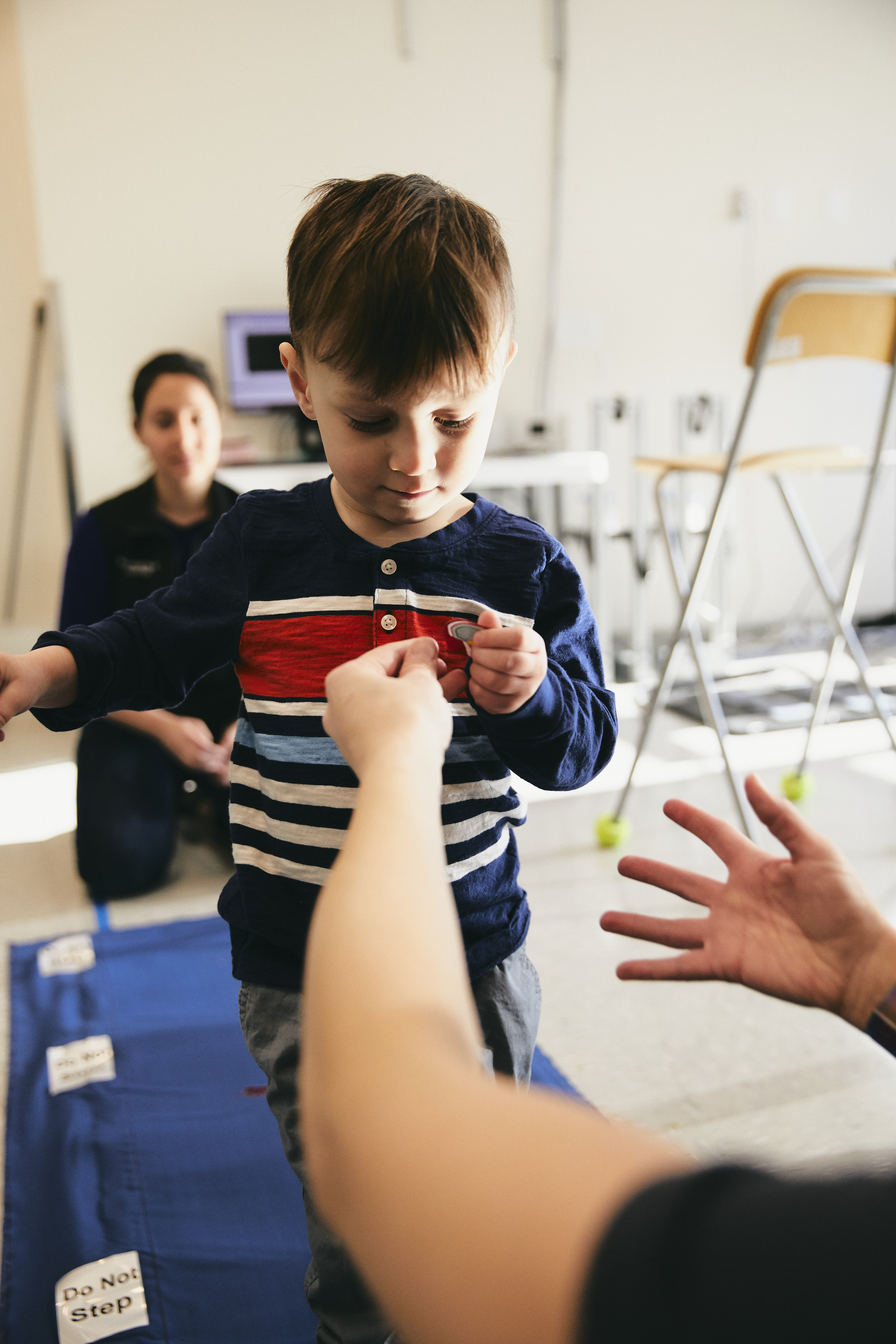Sensorimotor Performance and Rehabilitation Engineering Lab
(SPRE lab)
Virginia Chu, PhD, OTR/L Assistant Professor VCU Department of Occupational Therapy
Office location: 900 E Leigh Street, Room 5204
Lab location: 900 E Leigh Street, Room 5011
Email: spre@vcu.edu
Visit our lab website on RamPages: https://rampages.us/spre/
SPRE Lab Facebook
 The SPRE lab focuses on studying the role of somatosensory processing in motor control and development. We seek to better understand the development process of somatosensory function in children and how impairments and delays in sensory development affect motor development and learning. In particular, we focus on proprioceptive discrimination skills and the role these skills play in motor learning in children. A better understanding of the relationship between difficulties with proprioceptive processing and motor development will allow us to identify children who experience these difficulties before they show significant motor delays and to develop tailored interventions for them.
The SPRE lab focuses on studying the role of somatosensory processing in motor control and development. We seek to better understand the development process of somatosensory function in children and how impairments and delays in sensory development affect motor development and learning. In particular, we focus on proprioceptive discrimination skills and the role these skills play in motor learning in children. A better understanding of the relationship between difficulties with proprioceptive processing and motor development will allow us to identify children who experience these difficulties before they show significant motor delays and to develop tailored interventions for them.
Current Projects:
Development of Proprioception during Early Childhood
The purpose of this project is to examine proprioception development in very young children. Children participating in this study will play with the researchers and through these specially designed play activities, we will evaluate the child’s proprioception. Parents will also fill out some questionnaires about their children’s development. The results of this study will provide us allow us to develop tests to expand testing of proprioception into younger children. We will also be able to track and monitor sensory development in children who were born prematurely.
The role of proprioceptive processing in motor development
The purpose of this project is to develop a timeline of proprioception development in children. As part of this project, we will also develop assessment tools that will more accurately assess proprioceptive function. The developmental timeline will provide us with benchmark to compare deficits observed in children with developmental delays. It is only by effectively quantifying the sensory performance that we can evaluate effectiveness of sensory interventions and tailor interventions to a child’s unique needs.
Evaluation of sensorimotor performance in early childhood
Our lab is interested in developing new evaluation tools to improve the assessment of sensorimotor performance in young children. One of our latest projects is the development of a new online web version of the Quantitative Assessment of Prewriting Skills (QAPS). We are currently collaborating with Dr. Winters to conduct testing of the QAPS in partnership with the Children’s Museum of Richmond as part of the Living Lab exhibit.
Effect of stochastic resonance on sensorimotor function in stroke and cerebral palsy
The purpose of this study is to examine the feasibility of using stochastic resonance vibration (subthreshold tactile) applied to the wrist or ankle to improve sensorimotor function in individuals with cerebral palsy and post stroke. Particularly, we are interested in which sensory function the stochastic resonance impacts, and how that relates to observed motor improvements observed in some individuals. This research will allow us to further investigate the mechanism of how subthreshold vibration changes sensory function and to determine the characteristics of patients whom stochastic resonance vibration may potentially benefit.
Facilities and Equipment:
The SPRE lab is located in the CHP Building, Rm 5011. We are setup to measure movement, kinematics, kinetics and electrophysiology markers in children.
Equipment located in the lab includes:
- Active marker motion capture system
- Inertial based motion capture system
- Joint measurements: electrical goniometers, custom single-joint measurement setup
- Haptic feedback robotic arm
- Electrophysiological measurements: EMG, EKG, EDA
- Force sensors: force plates, dynamometers
- Pressure sensitive walkway
Selected Publications:
- Chu, V. W. T. & Dusing, S. C. (2022). Development and pilot testing of an early childhood somatosensory assessment: Somatosensory test of reaching. Developmental Psychobiology. DOI: 10.1002/dev.22334
- Reynolds, S., Daw, E., Babson, I.C., & Chu, V. (2022). What is Barth Tired? A qualitative approach to understanding fatigue in Barth syndrome from the perspective of family members. Journal of Rare Disorders: Diagnosis & Therapy, 8, (8), 1-8. DOI: 10.36648/2380-7245.8.8.72
- Chu, V. & Krishnan, K. (2022) Quantitative Assessment of Prewriting Skills in Children: The Development and Validation of a Tablet Assessment Tool. Perceptual and Motor Skills. 129 (3): 554-569. DOI: https://doi.org/10.1177/00315125221087802
- Chu, V., Girolami, G. L., & Grant-Beuttler, M. (2022) Assessing sensory processing differences in children with idiopathic toe walking: A pilot study. Physiotherapy Theory and Practice. DOI: https://doi.org/10.1080/09593985.2022.2073929
- Judd, N., Calhoun, H., Chu, V., & Reynolds, S. (2020). The relationship between sleep and activity level in males with Barth syndrome: A cross-sectional analysis. Journal of Rare Diseases Research & Treatment, 5(2), 24-30. DOI: https://doi.org/10.29245/2572-9411/2020/2.1194
- Chu, V.W. (2020). Pilot study to measure deficits in proprioception in children with somatodyspraxia. American Journal of Occupational Therapy, 74.
- Chu V.W.T., Hornby T. G., Schmit B.D. (2018) Stepping responses to treadmill perturbations vary with severity of motor deficits in human SCI. Journal of Neurophysiology, 120(2):497-508.
- Chu, V.W. (2020). Pilot study to measure deficits in proprioception in children with somatodyspraxia. American Journal of Occupational Therapy, 74.
- Chu V.W.T., Hornby T. G., Schmit B.D. (2018) Stepping responses to treadmill perturbations vary with severity of motor deficits in human SCI. Journal of Neurophysiology, 120(2):497-508.
Current support:
- NIH NICHD R01 (2023 - 2028)